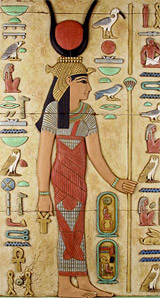“Throne”. Egyptian mother goddess. Daughter of Geb and Nut according to the Heliopolitan genealogy. Sister and wife of Osiris. Mother of Horus. She was depicted in human form, crowned either by a throne or by cow horns enclosing a sun disk. A vulture was also sometimes incorporated in her crown. She is sometimes depicted as a kite above the mummified body of Osiris. As the personification of the throne, she was an important source of the pharaoh’s power. Her cult was popular throughout Egypt, but the most important sanctuaries were at Giza and at Behbeit El-Hagar in the Nile delta. Isis later had an importan cult in the Greco-Roman world, with sanctuaries at Delos and Pompeii. Her Latin epithet was Stella Maris, or “star of the sea”.
 It was Isis who retrieved and reassembled the body of Osiris after his murder and dismemberment by Seth. In this connection she took on the role of a goddess of the dead and of funeral rites. Isis impregnated herself from the corpse and subsequently gave birth to Horus. She gave birth in secrecy at Khemmis in the Nile delta and hid the child from Seth in the papyrus swamps. Horus later defeated Seth and became the first ruler of a united Egypt. Isis, as mother of Horus, was by extension regarded as the mother and protectress of the pharaohs. The relationship between Isis and Horus may also have influenced the Christian conception of the relationship between Mary and the infant Jesus Christ. The depiction of the seated holding or suckling the child Horus is certainly reminiscent of the iconography of Mary and Jesus.
It was Isis who retrieved and reassembled the body of Osiris after his murder and dismemberment by Seth. In this connection she took on the role of a goddess of the dead and of funeral rites. Isis impregnated herself from the corpse and subsequently gave birth to Horus. She gave birth in secrecy at Khemmis in the Nile delta and hid the child from Seth in the papyrus swamps. Horus later defeated Seth and became the first ruler of a united Egypt. Isis, as mother of Horus, was by extension regarded as the mother and protectress of the pharaohs. The relationship between Isis and Horus may also have influenced the Christian conception of the relationship between Mary and the infant Jesus Christ. The depiction of the seated holding or suckling the child Horus is certainly reminiscent of the iconography of Mary and Jesus.